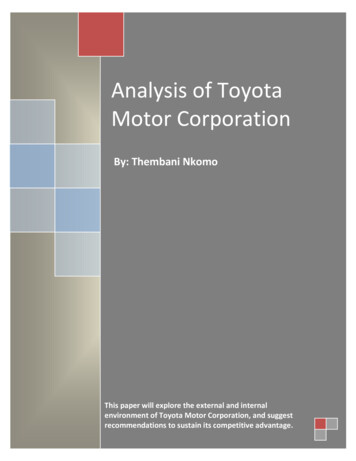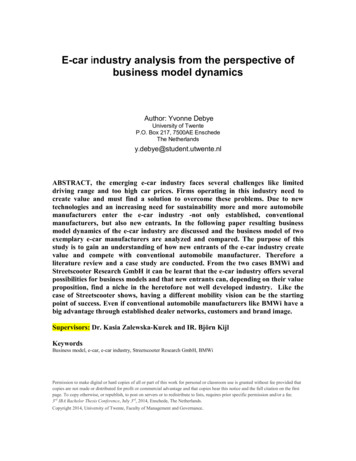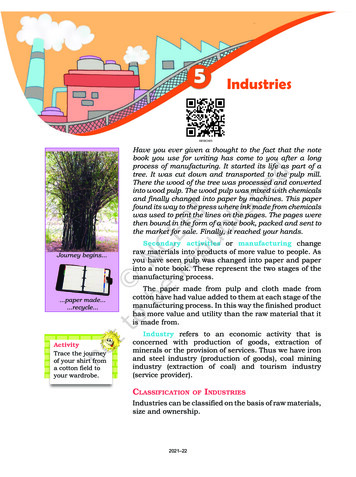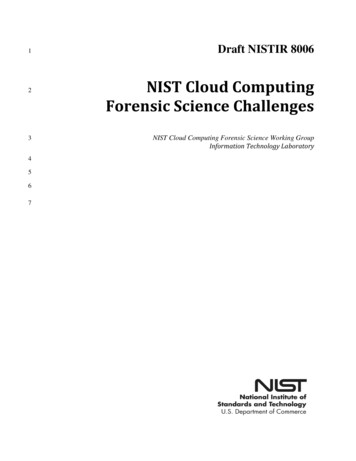
Transcription
DOI: 10.30699/ijrrs.2.1.4Vol. 2/ Issue 1/ 2019pp. 23-34Industry 4.0: Some Challenges andOpportunities for Reliability EngineeringMohammad Ali Farsi1* and Enrico Zio21. Aerospace Research Institute, Ministry of Science, Research and Technology, Tehran, Iran2. Energy Department, Politecnico di Milano, Milan, ItalyAbstractAccording to the development of Industry 4.0 and increase the integration of digital, physical and human worlds, reliabilityengineering must evolve for addressing the existing and future challenges about that. In this paper, the principle of Industry 4.0 ispresented and some of these challenges and opportunities for reliability engineering are discussed. New directions for research insystem modeling, big data analysis, health management, cyber-physical system, human-machine interaction, uncertainty, jointlyoptimization, communication, and interfaces are proposed. Each topic can be investigated individually, but this paper summarizes themand prepared a vision about reliability engineering for consideration and discussion by the interested scientific community.Keyword: Reliability engineering, Industry 4.0, Challenges, Big data, health management, cyber-physical system, Human-machineinteraction, jointly optimization, communication and interfacesIntroduction1The increasing integration of the digital, physical andhuman worlds makes a deep transformation in theindustry and we are witnessing the fourth industrialrevolution that it is called Industry 4.0. It providesopportunities to make the factories as an open platformand distributed systems with the dynamic structure thatthey are more efficient and faster, and more flexibleand resilient the complex supply chains [1]. The termIndustry 4.0 was first publicly introduced in 2011 ness in the manufacturing industry [2,3].The German federal government adopted the idea in itsHigh-Tech Strategy for 2020. Today, this concept isbecoming increasingly ubiquitous. Several researcheshave been performed to explain this idea and introduceits challenges and benefits, but more research in thisfield is necessary. In this study, some challenges andopportunities of industry 4.0 from the reliabilityengineering point of view is investigated.The Industry 4.0 conceptAccording to change in the manufacturing environmentand competition increasing among companies, we need a1. Corresponding Author Email: farsi@ari.ac.irReceived: 2019. 06. 30, Accepted: 2019. 07. 24new concept to define and make manufacturing factory,because the future industrial factories need a newparadigm to work as resilience and flexible system withreasonable cost. In this section, the past industrialrevolutions are reviewed to illustrate this new conceptbetter.In the eighteenth century, the first industrialrevolution caused major changes in industries by utilizingsteam power. Electric power and the assembly line formass production made the second industrial revolution.Computers and information technology were integratedinto manufacturing and the different computer-aidedsystems were produced in the third industrial revolution.Now, the fourth industrial revolution involves the heavyuse of automation and data exchange in manufacturingenvironments. The new systems utilize the advancedtechnologies, such as cyber-physical systems, the Internetof Things (IoT), 3D printing, digital twinge, andadvanced analytics, and cloud computing, and so on [4].Fig. 1 shows the transformation that happens.Therefore, industrial systems need to processdigitalization, cyber-physical system integration andsmart control on factory shop floors. Also, the efficiencyincreasing needs the integration of the supporting systemsinto the main system, such as maintenance, logistics andsupply change.
24 /IJRRS / Vol. 2/ Issue 1/ 2019Fig. 1. Industrial revolution through the years [1]In the other worlds, we deal with a smart system thatit is a system of the systems with dynamic structure. Thischange in industry improves the manufacturingenvironment and increase system speed and flexibility.Thus, investment level in smart manufacturing andindustry 4.0 has been rising rapidly and several countriesattend to this topic. Also, several types of research havebeen conducted to introduce and analysis industry 4.0 andsmart manufacturing systems. The brief review ofindustry 4.0 and smart manufacturing is presented asfollows.The first paper about industry 4.0 was published in2012 [4] and the abstract level description of Industry 4.0was given by Lasi et al. [5]. Stock and Seliger presentedextensive background research on the development ofIndustry 4.0 [6]. They also discussed the macro and microperspectives of Industry 4.0 with regard to sustainablemanufacturing and provided future scope in this domain.Mueller et al. [7] extensively studied industry 4.0 andfocused on the bottlenecks associated with theimplementation of Industry 4.0. They proposed amodulated architecture constituted of products, systemsoftware, processing, and manufacturing process. Lee etal. [8] proposed the implementation of cyber-physicalsystems (CPSs) in industry 4.0. CPSs provide theframework for close connections between physicaldevices and the cyber world. Condry and Nelson [9]proposed a more secure and efficient model for the IoTapproaches as compared to traditional models. Theirmodel considered the challenges and threats in the realworld scenarios and modeled them in the smart IoTdevices.Wang et al. [10] proposed a novel algorithm toperform the operations of the smart factory. Theysimulate intelligent manufacturing products that cancommunicate and cooperate with each other withouthuman intervention. Further, this setup was madereliable, by preparing a better decision makingenvironment to prevent deadlocks. The approach wasvalidated through some numerical experimentations.Kadera and Novák [11] worked on the chilled watermanagement system as an example to propose some keypoints to overcome the problems about communicationsbetween the interconnected devices in the industry.M.A. Farsi and E. ZioSmart manufacturing is an essential component inIndustry 4.0 paradigm which has fundamentally changedthe production industry. Smart manufacturing has helpedfactories achieve productivity gains of 17–20% whilstsimultaneously achieving quality gains of 15–20% [12].Challenges and bottlenecks in smart manufacturing fromthe past to now should be discussed and the futureresearches and improvement are introduced [13]. Huanget al. [14] described the latest work in the growth of thecommunity energy system planning (CESP) anddiscussed the basis of the smart industry techniquesapplied in CESP. They used a case study and declared thatCESP is the next big thing for energy systems in thefuture industry for which they have developed a platform.Andrew Kusiak [15] described the fundamentals of smartmanufacturing as a multi-thread perspective. He studiedmanufacturing resiliency and sustainability and explainedtheir differentiators with smart manufacturing.Several papers have been explained the industry 4.0and smart manufacturing, but reliability engineeringchallenges, bottlenecks, and opportunities have receivedless attention. The lecture shows that Zio discussedchallenges and opportunities in reliability engineeringfaced in big data [1]. He focused on knowledge,information and data application to analysis systems andonly discussed the challenges of prognostic healthmanagement and degradation models. He extended hiswork and explained the framework for risk assessment inthe new environment of industries [16]. This paperextends the previous study and covers other aspects ofindustry 4.0 challenges and opportunities for reliabilityengineers.Industry 4.0 Challenges and OpportunitiesAll future factories should work based on Industry 4.0paradigm. This concept was introduced based onmanufacturing systems but this idea can be applied indifferent industries, such as oil and gas, chemical plantsand power plants. Industry 4.0 has several benefits;increase production volume, fast response to customerrequirement, production waste reduction. But, theimplementation of industry 4.0 will need to satisfy severalfundamental requirements for manufacturing [17]: Enterprise integration and interoperability Distributed organization Model-based monitoring and control Heterogeneous systems and environments Open and dynamic structure Cooperation and Collaboration Integration and interoperability of humans withsoftware and hardware systems Agility, scalability and fault tolerance Interdependent networks Service-oriented collaborative manufacturingplatforms
Industry 4.0: Some challenges and opportunities for Reliability Engineering Data-driven analysis, modeling, control, andlearning systems for decision-making support.Also, different types of technology should be set tobuild a smart factory [18-20]. These technologies includeseveral software, advanced collaborative robotics,modular and adaptable configuration, high-speed systemsfor data transfer, and other. To obtain a fully smartsystem, we need smart supply chains, smart maintenancesystem, smart labor and so on. This type of system dealswith several challenges from the technical point of view.Thus, some companies could not implement this idea andit is still a long way to go.We know every manufacturing system should be reliableand its availability is reasonable. Also, security, safety andmaintainability should be considered in the design,implementation and utilization steps. Thus, when a smartfactory or industry 4.0 idea is studied, these challenges andopportunities from the reliability engineering view of pointhave to be considered. In the rest of the paper, the mainchallenges and opportunity are discussed.Challenges and Opportunity for ReliabilityEngineeringReliability engineering as a sub-discipline of systemengineering includes the systematic application of theengineering principles and techniques throughout aproduct lifecycle so reliability should be considered fromconcept plan to wear out of the system/product.Reliability engineer defines reliability requirements,predict, analysis, assess and optimize systemperformance via reliability techniques.Industry 4.0 makes the new opportunity for thoughtleaders and engineers to create new systems and innovatesmart devices and instruments. These innovationsfacilitate infrastructures for industry development, butalso generate new and unknown failure mechanisms, newand unknown economic, functional, technical andstructural dependencies among system components, andeventually new and unknown hazards and risks. On theother hand, with complexity and dependence increasing,the implementation of new concepts, and theadvancements in knowledge, methods and techniques,such as big data, internet of things and quick response tochanges, make new opportunities for developingreliability engineering techniques and improve reliabilityprediction capability. In the rest of this study, somesubjects related to reliability and industry 4.0 interactionsare discussed.System ModelingIndustry 4.0 integrates different engineering systems anddisciplines. A system built based on this concept includesadaptive systems with differing levels of autonomy andall human activities are interconnected by a lot ofcommunication systems at the moment [21]. This systemoften has multi-components, open, resilience andIJRRS: Vol. 2/ Issue 1/ 2019/ 25dynamic structure managed based on online datacollection and analysis. The first challenge is the systemmodeling and the system definition for this type of systeminvestigation. Although different researchers tried tosystem modeling via reliability engineering techniques,this type of system modeling and analyzing is aninteresting topic for reliability engineers. Severaladvanced methods and techniques have been developed,such as dynamic fault tree [22], dynamic Bayesian [23],dynamic reliability block diagram [24], Markov chain[25] and Monte Carlo simulation [26]; but this topic needsmore attention. The system that used in Industry 4.0context consists of the new aspects and deal with the newchallenges such as Cyber-Physical Systems (CPSs),reliance structure, supporting systems, multi-statecomponents, distributed structure and so on. Thesechallenges are discussed in the next sections.Cyber-Physical Systems are electronic controlsystems that control physical machines, and the mainstructure of the industry 4.0 [17,27]. CPSs provide theframework for close connections between the cyber worldand physical devices. Thus, modeling and analysis ofCPS as an embedded system is very crucial.Resilience system is the new types of engineeringsystems which have recently raised significant interestamong both practitioners and researchers due to its role inreducing the risks associated with the inevitabledisruption of systems [28]. Dinh et al. [29] identified sixfactors that enhance the resilience engineering ofindustrial processes, including minimization of failure,limitation of effects, administrative controls/procedures,flexibility, controllability, and early detection. Differentdefinitions have been proposed for resilience systems[28], but most of them emphasize the system dynamic,adaptive control and recoverability. Adaptive control,online decision and re-configuration of the structure areessential portions of industry 4.0. In this condition, eachsub-systems duty is defined based on its state and othersub-systems conditions. This dynamic dependencemodeling is complicated and makes the big challenge forsystem modeling. A recent trend in resilience measureshas been accounting for aleatory and epistemicuncertainty with stochastic approaches [28]. Also,addressing larger temporal and spatial scale, integratingmore human and social aspects and employing moresmart resources and solutions [30] and develop a newmodel to the time-dependent characteristic of systemresilience are the new directions for resilience systemmodeling [31].In industry 4.0, often, we deal with a system of systemsthat covers all aspects which impress system efficiency andperformance. Then, system modeling is complex anddifferent disciplines and supporting systems such asmaintenance, spare parts inventory, logistics, warranty andafter sale service, and others should be jointly considered.Supply chain and maintenance recently have beeninvestigated by researchers [32-34]. Supplier selection,quality, logistics, storage management, spare parts
26 /IJRRS / Vol. 2/ Issue 1/ 2019inventory, and cost are studied and jointly optimization ofsupply chain and maintenance is considered. But study aboutthe integration of maintenance, supply chain, and productionplanning is rare. When we talk about the factory for future,this necessity is being more highlighted.A multi-state system is a kind of system in whichboth the system and its components may display multipleperformance levels, and it can be utilized to the modelingof the complicated and practical systems. Futureengineering systems may use this scheme as a basestructure or performance of this system according to thedegradation of the system outcome is modeled by multistate system techniques. When this structure is dynamicand includes software and hardware systems, the systemcomplexity is increased and we deal with explosive states.Also, different components of the system have differentbehavior and follow a specified probability distribution.Thus, hybrid methods should be developed [35]. Studyabout the hybrid approaches especially hybrid Bayesianapplication as an advanced method to solve reliabilityproblems is rare, and according to big data and a lot ofevidence, Bayesian infer can be investigated moreespecially in reliability prediction, diagnosis and faultdetection, and risk reduction of the system. A recent trendin the multi-state system has been accounting fordependence modeling among components [36-37].Practical systems consist of the differentcomponents, so multi-component systems assessmentrecently receive more attention. Several dependencies canexist among the system components; the dependenciescan be grouped into four types [38]: structural, resource,stochastic, and economic dependence. An optimal andreasonable plan to reliability assessment should considerthese dependencies and the relations among the differentcomponents. Also, different levels of uncertainty insystem components, different environment condition,exchange information among the components, thedifference among components ages and different levels oftechnology are the main problems of the system.Recently, dependence modeling is a portion of the newresearches about reliability engineering.Today, companies attend to build new sites in othercountries to optimize their performance, for instance, indeveloping countries. International cooperation isincreased in business. Thus, we deal with the multinational company and distributed system. In traditionalform this relation is low, but when smartness is increased,the new problem and challenges appear. Today, the businessmodel and supply chain management are studied [39]. Subsystems are assumed as independent components, andarranged individually based on local regulation andrequirements. But the factory of the future needs moreintegration. Security, dependency and reliability, theeffective management of a diversified business,encompassing diversity in human resource, technicalcapacity, and technical problems are their challenges whichmust be navigated in ensuring business success.M.A. Farsi and E. ZioOther challenges in system modeling are modelingtools and techniques, also interfaces among reliabilityengineering and other system engineering aspects such assafety, risk. Therefore, advanced methods especiallyBayesian approaches [40] should be more considered andnew concepts for system modeling is developed.Big Data and Data ProcessingAdvanced instruments and facilities are applied in thesmart systems and data at different stages of a product’slife, such as raw materials, machines’ operations, facilitylogistics, quality control, product utilization and warrantyduration is collected and analyzed. This data’s role inindustry 4.0 and smart systems is crucial and big dataempowers companies to utilize data-driven strategies tobecome more flexible and powerful for marketcompetition. Data collected from manufacturing systemsare very important and must be stored and analyzed. Inthe past, data was documented on paper, with industrialdevelopment and the integration of informationtechnology and manufacturing, also computerizedsystems utilization, data is collected and saved on amachine. Recently, the capability of informationtechnology is quickly grown up and advancedtechnologies (e.g., Internet of Things, cloud computing,big data analytics, and artificial intelligence) areintroduced and simultaneously applied in industrial andbusiness systems. Systems integration with IT leads touse of a new paradigm as industry 4.0. Fig. 2 shows theevolution of data in manufacturing systems, similarintegration for other systems can be assumed.Fig. 2. Evolution of data in manufacturing systems [41]Big data collected have to be processed and appliedto improve system performance. This data consists ofdifferent type of parameters with different quality andform because several sensors and sources are applied.Some part of data may be collected as voice, video,image, electronic signal and other, these data should bepre-processed, processed and analyzed for application.Crude data is not useful and it may include noisy data,thus, this data should be translated into concreteinformation content and context that can be directlyunderstood by users. Thus, we need advanced methods
Industry 4.0: Some challenges and opportunities for Reliability Engineeringsuch as cloud computing, neural networks and deeplearning [42].Cloud-Based Big-Data processing techniques as aninteresting topic have been investigated in the pastdecades, different computing models have been proposedbased on different platform and focus, such as batchbased, stream-based, graph-based, directed acyclic graphbased, Interactive-Based and Visual-Based processing[43].Neural networks are a useful tool in reliabilityengineering, especially for remain useful lifetimeprediction [43], Farsi and Hosseini used ANN to reducenoise effect and estimated a bearing lifetime [44].Although ANN is a useful tool for data processing, deeplearning is more effective. Deep learning benefits includereducing operating costs, keeping up with changingconsumer demand, improving productivity and reducingdowntime, gaining better visibility and extracting morevalue from the operations for global competitiveness[42]. Different models have been developed inmanufacturing, as shown in the table below.Table 1. The deep learning models and application inmanufacturing [42].Deep learning modelConvolutional Neural NetworkDeep Belief NetworkAuto EncoderRecurrent Neural NetworkApplication ScenariosSurface integration inspectionMachinery fault diagnosisMachinery fault diagnosisPredictive analytics & defectprognosisMachinery fault diagnosisPredictive analytics & defectprognosisThe advance in computing techniques and dataprocessing impress design methods and computer-aidedengineering systems, for example, different types offailures in the system can be modeled and evaluated bysimulations. This capability increases knowledge aboutthe failure mechanism to avoid them in the utilizationstage. Reliability engineer can use these capabilities toimprove reliability prediction of a new product in thedesign step. On the other hands, designers incorporateArtificial intelligence (AI) and deep learning into newproducts and in their own design processes. Design engineerswill be challenged to use these tools in their own designprocesses to more quickly optimize final designs [45].Xue et al. use deep learning to accelerated search formaterials with targeted properties by adaptive design[46].Another challenge in big data processing is thedynamic behavior of the system. The used model tosystem modeling should be adapted based on the systemage, degradation behavior and condition. Because datacollected real-time, may change the pre-defined model ofthe system. Therefore, model updating can be consideredas an interesting topic in this field [1].Big data and data-driven methods are almost appliedto improve maintenance management. Maintenance is aIJRRS: Vol. 2/ Issue 1/ 2019/ 27method to keep a system or component in a good andacceptable state. Different maintenance disciplines areapplied to avoid catastrophic and unexpected failure, forinstance, condition based maintenance (CBM) isfrequently applied in modern systems, such as locomotiveengines, aircraft engines, aircraft bodies, dams, powerdistribution transformers, and wind turbines.In CBM policy, critical components are monitoredand controlled; data are collected and processed to makethe best decision for system holding. In a CBM systemdegradation is monitored and controlled to decrease thedegradation processes develop. Thus, degradationmodeling is an important topic for reliability engineers sodifferent models have been proposed about that. Duringthe last two decades, a number of degradation modelshave been developed to analyze the degradation dynamicsof a product. These models are categorized as follows [1]: Statistical models of time to failure Stochastic process models Physics-based models (PBMs) Multi-state models (MSMs).Ye and Xie [5] have given an excellent review of thisarea. In the lecture, very few studies have considereddegradation dependence in a system whose degradationprocesses are modeled by PBMs and MSMs, and severalfactors which can influence degradation evolution, thus,research about degradation modeling must be continued.All these models need data and their accuracydepends on the data volume and quality. Industry 4.0produces big data. Therefore, we can increase theprediction accuracy of these models. Also, big data helpsto modify these models based on actual conditions orprovide an opportunity to develop a new model as newdirections of research.Different types of components are used in a system,some components are critical and their role is crucial. Theinfluence of some components on the system is low, andcontinuous monitoring isn’t reasonable from technical oreconomical points of view. These are inspected orchecked based on time tables. The optimal duration forinspection impresses data integrity as well as the cost. Itis obvious that data integrity is very important and bigdata without integrity is not applicable. Therefore,determine optimal inspection times are important forholding the system at the desired level ofreliability/availability and risk reduction. Several studieshave been carried out in this field [47-48], recentlydynamic framework for inspection has been receivedmore attention [49], but we need more research in thisfield.Sometimes system suddenly failed because ofenvironmental conditions variation and excessiveloading. Industry 4.0 improve system capability, butrandom failures can’t be eliminated. Also, according toour lack of knowledge about a failure, we may not detectand prevent a failure. This event randomly occurs byexternal shocks same as mechanical, thermal or electricalshock. For example, the data in a computer system are
28 /IJRRS / Vol. 2/ Issue 1/ 2019frequently updated by adding or deleting them and arestored in secondary media. However, data files aresometimes broken by several errors due to human errors,incompatibility, noises, and hardware faults. Accordingto the severity of the damage and its risk, research aboutthese events modeling needs to be conducted. In a shockmodel, a system (or component) is subject to shocksoccurring randomly in time. Over the past severaldecades, various shock models have been introduced andstudied. Basically, those shock models fall into fivecategories [48]: Cumulative shock model, extreme shockmodel, run shock model, δ-shock model (delta-shockmodel) and mixed shock model. Recently, the healingability of systems is considered by some researchers whostudy shock models. This topic includes ‘curable’ shockprocess and self-healing mechanism. The reliabilitymodeling and assessment of multiple components andmultiple self-healing abilities could be developed [50].Mixed shock model [51], Joint optimization ofmaintenance policy and spare parts inventorying thesystem could also be further studied.Prognostics and Health Management and big dataPrognostics and Health Management (PHM) is a field ofreliability engineering that consists of the detection of theengineering component degradation, the fault typediagnosis, the failure time prediction and proactivelymanaging of their failures. In other words, it is a processthat predicts the future reliability for systems or productsby determining the amount of the deviation ordegradation of them from their expected normalsituations. Remained useful lifetime (RUL) is the mostimportant portion of PHM that it is estimated by the datadriven, physical model, experimental based and hybridmethods [52]. Most of these methodologies depend ondata. In traditional PHM methods, data volume is limitbecause this data is collected from a single element ordata acquisition isn’t a continuing process. Then, thesemethods can not satisfy Industry 4.0 requirements andnew and modern methods should be developed to use bigdata and predict system future, such as deep learning [53],health index similarity [54], on-line method [55]. Anotherproblem is drift concept because we deal with a dynamicand resilience system and the relation between inputs andoutputs of the system continuously changed. Thus, weneed dynamic models updated using new input-outputdata collected in the new situations, especially, whenthere is multi dependence among components or failuremodes. Several concepts are developed to drift detectionand model updating [56-57], but it is necessary to moreresearch in this field.Another challenge for PHM methods is theircapability to scale-up their results to the whole of thesystem. Fleet management deals with similar challengesto implement a distributed intelligent dynamicmaintenance management system. Fleet maintenanceprogramming is difficult [58] and different environment,different culture, oriented to mission reliability andM.A. Farsi and E. Ziodifferent age of facilities and etc. increase this casecomplexity and make interesting topics for futureresearch. On the other hand, the similarity in function andstructure of this case cannot be ignored and data diffusionis an interesting subject for research.Cyber-physical systemSince the decade 1950 that the first computerizedmachine was introduced and then software controlled ahardware (mechanical or electrical elements) [59], theinteraction between hardware and software has appeareda challenge. This interaction has raised up with IT andcyber-physical systems (CPSs) developing so that todaythey are the foundation of Industry 4.0. The firstdefinition that can be found about CPS dates from 2006,during a workshop with the American National ScienceFoundation (NSF). In the past decades, many types ofresearch carried out about notions and concepts that havebeen at the origin of current CPS. Fig. 3 shows theprinciple of CPS. CPS promotes intensive connection onal software providing and using dataaccessing and data-processing services simultaneously.The main benefits that can be expected from theapplication of CPSs in manufacturing are summarized as[60-62]: optimization of production processes, optimizedproduct customization, resource-efficient production, andhuman-centered production processes.Fig. 3. The CPS principle [17]CPS has three basic capabilities mmunication), and Responsiveness (control). Eachcapability deals with challenges that should
industry 4.0 and smart manufacturing is presented as follows. The first paper about industry 4.0 was published in 2012 [4] and the abstract level description of Industry 4.0 was given by Lasi et al. [5]. Stock and Seliger presented extensive background research










